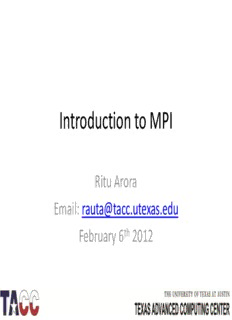
Parallel Programming with MPI PDF
Preview Parallel Programming with MPI
Introduction to MPI Ritu Arora Email: [email protected] February 6th 2012 Course Objectives & Assumptions • Objectives – Teach basics of MPI-Programming – Share information related to running MPI programs on Ranger & Lonestar • Assumptions – The audience has the basic understanding of C programming • Fortran binding will be mentioned where necessary – The audience has access to MPI installation either locally or remotely 2 Content Overview • Basic concepts related to MPI • Environment Management MPI routines • Compiling and running MPI programs • Types of communication – Point-to-Point communication routines – Collective communication routines • Examples • Summary 3 Message Passing Interface (MPI) • MPI is a standard/specification for message passing library – Multiple vendor-specific implementations • Mainly used for programming systems with distributed memory – Where each process has a different address space – Processes need to communicate with each other • Synchronization • Data Exchange – Can also be used for shared memory and hybrid architectures • MPI specifications have been defined for C, C++ and Fortran programs • MPI-1 versus MPI-2 4 Explicit Parallelization with MPI (traditional way) 5 Divide & Conquer Memory Memory Block 1 Block 2 Node-1 Node-2 Message Passing Interface Interconnect Block 3 Block 4 Node-4 Node-3 Memory Memory 6 Concept of Communicators and Groups • Communicators and groups are objects that are used to define which collection of processes may communicate with each other • Most MPI routines require a communicator as an argument • MPI_COMM_WORLD is the predefined communicator that includes all MPI processes • Multiple communicators and groups can be defined 7 Source: https://computing.llnl.gov/tutorials/mpi/ General Structure of MPI Programs 8 Source: https://computing.llnl.gov/tutorials/mpi/ Arguments for MPI Routine (buffer, data count, data type, destination) • Buffer: the name of a variable (including arrays and structures) that is to be sent/received. For C programs, this argument is passed by reference and usually must be prepended with an ampersand: &var1 • Data Count: number of data elements to be sent or received • Data Type: could be elementary data type or derived • Destination: the process where a message is to be delivered 9 Arguments for MPI Routine (source, tag, status, request) • Source: indicates the process from which the message originated • Tag: non-negative integer value to uniquely identify a message • Status: for a receive operation, indicates the source and tag of a message • Request: a unique “request number” issued by the system that can be used to check if a particular category of operation has completed or not (more on this later) 10
Description: